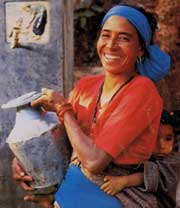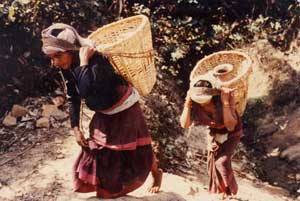 Remember all those public service advertisements about safe drinking water? Turns out there was no reason to snigger at them. Consider this: in the early 1960 only five percent of rural Nepalis had access to piped drinking water. Today 80 percent do.
Remember all those public service advertisements about safe drinking water? Turns out there was no reason to snigger at them. Consider this: in the early 1960 only five percent of rural Nepalis had access to piped drinking water. Today 80 percent do. In that same period, Nepal's child mortality rate has dropped from 300 per 1,000 live births to less than 100. There is a correlation between safer drinking water and healthier children, and Nepal's success with rural drinking water has become a model for other developing countries. But this is now threatened by the Maoist insurgency-in the past month rebels have started targetting water supply pipelines in rural areas.
Drinking water isn't only about slaking one's thirst, it isn't just a commodity. "Drinking water is a social issue. It is about mobilising communities, changing people's behaviour, it is about health and women's empowerment," says Dr Vijaya Shrestha, who worked with the government through three phases of the Rural Water Supply and Sanitation Sector Project.
A reliable supply means infants won't die of diarrhoeal dehydration. It means women and girls who spend hours fetching water with gagris on their hips can use that time and energy for other activities, such as taking their goods to the market, or studying. It means people can make the next step to building-and using-toilets, which in turn means better hygiene and healthier, more productive Nepalis.
As grants dry up and the emphasis internationally shifts to making communities manage their drinking water systems, Nepal too has in recent years tried to use the greater decision-making powers of women and ensuring that systems are locally sustainable with the primary concerns of sanitation and hygiene.
Water planners say we must understand that water supply is a right. Once that is taken as a given, water becomes an agent of social change. The numbers show that this approach holds water and in 1997, the international Water Collaborative Council recognised Nepal's drinking water campaign as one of the best in the world.
 Nepal's model works like this: a community must first demand a water supply system, it must identify a perennial water source. Then, a local committee is appointed to maintain the system. Finally, villagers sit down to decide where the taps should be placed, contribute labour, and find funds for construction. After this they're on their own. What keeps the project going is the involvement of community right from the start, giving villagers a sense of ownership as well as an understanding of how the system works. The other reason Nepal's experiment with community-managed drinking water has been so successful is that the technology needed was simplified and adapted to local conditions, and so could be built and maintained with locally-produced spare parts.
Nepal's model works like this: a community must first demand a water supply system, it must identify a perennial water source. Then, a local committee is appointed to maintain the system. Finally, villagers sit down to decide where the taps should be placed, contribute labour, and find funds for construction. After this they're on their own. What keeps the project going is the involvement of community right from the start, giving villagers a sense of ownership as well as an understanding of how the system works. The other reason Nepal's experiment with community-managed drinking water has been so successful is that the technology needed was simplified and adapted to local conditions, and so could be built and maintained with locally-produced spare parts. Namaste Lal Shrestha of UNICEF says, "Now the communities do not need foreign trained technicians like us, they can do just fine by themselves." Village folk now also know that they don't need to depend on Kathmandu for money or experts, and it is this local involvement that has also de-politicised rural drinking water supply.
However, policymakers and community leaders now tell us that the next step is to get the government back in-with a few changes in attitude. "The government needs to realise fast that supplying good quality drinking water makes economic sense," says Umesh Pandey, member secretary of Nepal Water for Health (NEWAH).
A 2001 study by the research group New Era on the fourth phase of the Asian Development Bank-funded Water Supply and Sanitation Sub-Project shows that the average time to fetch one vessel of water came down from an hour to ten minutes after the project was implemented. The major beneficiaries were women, and when water supply improves more and more women attend informal education classes and participate in savings and credit schemes. They spend more time on caring for their children and preparing food, and they even sleep better. There is more time to take produce to market, children (especially girls) have more time to study.
Biman Kumar Paudel, an environmental engineer with the Department of Water Supply and Sewage who has worked with grassroots communities for two decades, says there is an even more remarkable change: "In areas that have community-managed drinking water supply systems, not only has the health and hygiene of women improved, they have also become significantly better leaders."
 UNICEF and some 25 other national and international organisations working in rural drinking water caution that the next big push should be in sanitation-constructing lavatories. The New Era survey showed that areas with new water supply saw a two-thirds drop in incidence of diarrhoea. These improvements can be enhanced when water supply is coupled with better hygiene.
UNICEF and some 25 other national and international organisations working in rural drinking water caution that the next big push should be in sanitation-constructing lavatories. The New Era survey showed that areas with new water supply saw a two-thirds drop in incidence of diarrhoea. These improvements can be enhanced when water supply is coupled with better hygiene. Hans D Spruijt, who heads UNICEF's Water and Environmental Sanitation section, has calculated it all: "Access to plenty of water reduces diarrhoea by 20 percent, maintaining the quality of water for drinking purposes reduces it by another 15 percent and washing hands properly and at right time can reduce it by an additional 35 percent. This means access to good quality drinking water can reduce the incidence of diarrhoea by 65-70 percent." Diarrhoea and diarrhoea-related deaths acount for close to a third of infant morbidity and mortality.
Although the approach remains women-focused, there is reason to believe that when it comes to loos, men make the call. UNICEF's statistics show that while 80 percent of households in Nepal have access to safe drinking water, only 30 percent have proper toilets. Over half the households without safe toilets told UNICEF that they couldn't afford them, but the agency maintains that people's attitudes and habits are the main obstacles.
One in four simply said that they didn't have toilets because they weren't in the habit of using them. "The women-centred approach was also part of the problem. Initially we didn't realise the significance of mobilising and motivating men, who control the resources of families," NEWAH's Pandey told us. Even if the women understand the need for proper toilets, the men in their households decide it is not the priority.
Maoists target rural water supply
In the coming monsoon season, the biggest problem won't be implementing new water and sanitation projects. It will be the insurgency. "More people will fall ill this monsoon season," UNICEF's Hans Spruijt predicts. Because of the conflict and the state of emergency, most organisations working on drinking water projects have been forced to reduce their programmes by half.
Hari Ram Koirala, deputy director general of the Department of Water Supply and Sewerage (DWSS) is keeping his fingers crossed that community-managed systems will be spared by the insurgents. "Our grassroots-level workers have not been harassed by the Maoists so far, even in very sensitive districts like Rukum and Rolpa," he said. But he is still nervous, wondering whether the attacks on the DWSS' local partners, such as village and district development committees, and of late on large-scale drinking water projects, could be portends of bad times ahead.
In the past month, the Maoists have attacked water supply in Okhaldhunga, Dailekh and a dozen other districts. In Humla, metal pipes laid down at enormous cost for rural water supply have been uprooted by Maoists. "This is a disaster," says Jivan Shahi, chairman of the Humla DDC. "More children will die."


